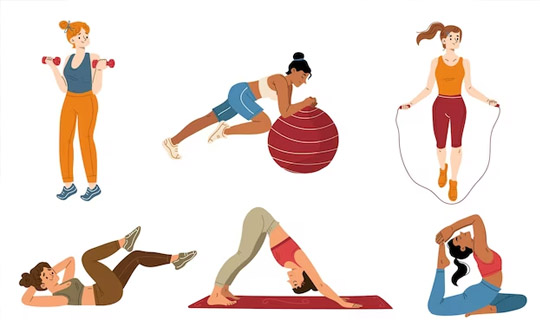
I. INTRODUCTION
Flexibility refers to the range of movement or motion (ROM) of a joint (e.g., elbow) or a series of joints (e.g., spine). In other words, flexibility is the ability of a joint to move freely through its full normal range of motion. Good flexibility allows maximum ROM during our day-to-day work and improves our performance in exercise. It also prevents injury like muscle tears or low back pain. As we age, we experience a progressive loss of flexibility due to disease, deterioration of joint structures, etc. In combination with loss of strength, loss of flexibility plays a significant role in accidental falls-related injuries in advance age. Stiff muscles or stiff connective tissues restrict full ROM.
There are two important things about flexibility training. Firstly, a flexibility training must address all primary joints or series of joints for overall flexibility. Unless this is done, it is quite possible that a person may have excellent flexibility in a certain joint and at the same time he may suffer from poor flexibility of some other joint. Secondly, it has been found that flexibility can be improved at any age by proper stretching exercises.
Inclusion of flexibility training in warm-up and cool-down phases (though traditionally recommended) is now a matter of debate. Some authors are of the opinion that static stretching during warm-up phase may actually adversely affect the force-producing capabilities of muscles. This school of thought recommends that a warm-up session consisting of only cardio-respiratory exercise may be more effective in increasing flexibility than static stretching. However, in my opinion till the time this debate is settled, it is safer to include flexibility training during warm-up and cool-down process.
BENEFITS
(i) Flexibility training prevents stiffness of joints and makes our day to day movements comfortable.
(ii) It prevents injury during sudden or excessive movement of joints. For example, a person with less flexible spine is more likely to incur injury during sudden bend to catch a falling glass.
(iii) It is very relaxing. Yogic stretching (Yogasanas) is far more beneficial than normal stretching. It improves not only ROM of joints, but also helps internal systems (nervous system, digestive system, etc.).
(iii) II. FLEXIBILITY TRAINING PROGRAMME DESIGN:
A. Frequency - It should be done preferably on every day. Discontinuity of flexibility training even for a week drastically reduces our flexibility. Secondly, briefly stretching a muscle immediately after completion of each set removes lactic acid and helps faster recovery. For example, after completing a set of push ups, immediately stretch your pectoral muscles for faster recovery; or, stretch your quadriceps and hamstrings immediately after each set of squats, and so on.
B. Intensity - Stretching should be done to the point of slight discomfort but never to the point of pain. At least in matters of stretch, never compete with anyone. There would be sure chance of injury.
C. Time - Stretching during warm-up and cool-down may be for shorter duration (10-15 seconds each stretching). However, for improvement of flexibility, stretching should be for 30-60 seconds duration. During holding period of stretch one should breathe normally. Holding one’s breath may cause dizziness.
D. Type - There are mainly two types of flexibility training –
(i) Active stretching – Hold a stretch at the extreme of ROM of a joint for 10-30 seconds.
(ii) Passive stretching – Take assistance of partner or equipment (e.g., towel, rope) to reach you full ROM.
Ballistic or bounce stretching is done to achieve greater ROM by using momentum of the body or bouncing. It is a very popular type of stretching in traditional physical training programmes. It is in fact flexibility and endurance training combined together. However, for not so well conditioned individuals it may be potentially dangerous as uncontrolled bouncing may cause injury.
Back to top >
III. EXERCISES TO IMPROVE FLEXIBILITY
1. For neck –(i) • Sit (or stand) upright.
Roll the head in a circle from left to right 2-3 times.
Do the same from right to left.
(ii)• Bring the chin down to touch your chest. Hold for 5-10 seconds.
Lift your chin up and stretch your neck backward. Hold it for 5-10 seconds.
(iii)• Bend your head over left shoulder. Hold it for 5-10 seconds. Bend your head over right shoulder. Hold it for 5-10 seconds.
2. For shoulders – (i) • Stand or sit upright.
Position your hand on your shoulders as shown in fig-66.
Rotate your elbows forward, 10 times.
Rotate your elbows backward, 10 times.

Rotate the shoulders forward and make a big circle with the arms 2-3 times (fig-67)
Rotate the shoulders backward and make a big circle with the arms 2-3 times.

Stand upright with your back against a window bar. Grip the bar at waist height.
While gripping the bar, try to move away from the bar as far as possible fully extending your arms (fig-68). Hold the stretch for 10 seconds.
Keep your body upright throughout.
This is good stretch for deltoids and biceps also.

(i) • Stand or sit upright.
Extend your arms at shoulder height, palms facing outward. Interlace your fingers (fig-69)
Extend the arms and shoulders further forward till you feel stretch in upper back. Hold it for 10 seconds.

Move away from the bar as far as possible (till you feel the stretch in your upper back). Hold it for 10 seconds. (fig-70)
Keep your posture upright throughout.

Do Bhujangasana as described under section on Yogic stretching.
6. For Quadriceps –
Stand upright.
Grip the ankle of left leg with right hand and pull it so that your left foot heel touches your right hip (fig-71)
Hold it for 10-15 seconds.
Do similar stretch with right leg with left hand.

(i) Do Pashchinmottanasana. If you have problem in bending forward, do this –
Sit down on floor extending right leg to the front closing left leg to your body as in fig-72.
Grip the ball of the left foot with both hands and extend the left leg to the front as far as you can. (fig-73)
Hold it for 10-15 seconds.
Extend left leg to the front and close right leg to your body.
Grip the ball of the right foot with both hands and extend the right leg to the front as far as possible.
Hold it for 10-15 seconds.

Adopt lunging position with left foot forward and right leg straight (fig-74)
Lean forward to stretch the right groin muscles. (fig-75) Hold it for 10-15 seconds.
Repeat the similar action with right foot forward and left leg straight to stretch left groin muscles.

(i) • Stand on the edge of a stair as shown in figure-47.
Hold it for 10-15 seconds.
(ii) • Lean against a wall with left foot forward and right leg extended (fig-76)
Lean further keeping your back straight and right foot firmly planted to feel stretch in right calf. Hold it for 10-15 seconds.
Keep the right heel on the ground throughout.
Do similar action with right foot forward and left leg extended.

Lean against the wall as described in stretching exercise number alternatively.
Raise your heel slightly above the ground to stretch ankles.(fig-77)
Yogic stretching
1. Pashchimotanasan - This asana stretches almost whole body, particularly hamstrings, calves and small of the back. It improves digestion also.
Sit erect. Stretch out legs. (fig-78)
Bend forward and grasp your toes.
Pull the toes towards yourself and rest your forehead on the knees. (fig-79)
Maintain the stretch for 20-30 seconds.
Come back to starting position.

Don’t do this asana if you have lower back problem.
2. Bhujangasana – This is an excellent stretching for the back and whole spinal column.
Lie on your abdomen, keeping arms close to your sides, palms beneath shoulders. (fig-80)
Pushing the ground with your hands. Bend backward till your upper abdomen is up and navel still touching the ground.(fig-81)
Maintain the stretch for 20-30 seconds.
Come back to the starting position.


Lie on your abdomen. Bend the legs and grasps ankles. (fig-82)
Pull the legs upward and simultaneously raise upper body. Aim to balance your body on the navel region. (fig-83)
Maintain the stretch for 5-10 seconds.
Come back to the starting position.


This can be done in traditional sitting position (fig-84) or even in upright sitting or standing position.
Bring the left arm behind the back, palm facing outward, moving up along the spine. Push the forearm up as far as possible.
Folding the right ear, palm facing inward, slide down the right hand forearm behind the back till the right hand touches the left hand. (fig-84)
Aim to lock the forefinger of both hands together.
Hold it for 10-15 seconds.
Return to the original position.

IV. SAFETY FACTORS
Preferably stretching should be done only towards the end of warm-up.
Stretch to the point of discomfort, but not pain. There will not be any gain from this pain.
Never stretch an injured part. It will further aggravate the injury.
Adopt correct form and technique.
Breathe normally.
All movements should be in rhythmic manner.
Sometimes too much of flexibility may be too good to be desirable. Excessive flexibility may lead to injury especially in heavy weight lifting exercises.
Focus your mind on correct technique of movement. Try to do it better than the previous day.
Don’t do forward bending in case of any lower back problem.



